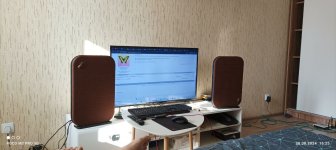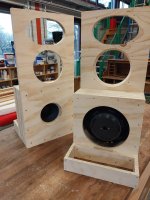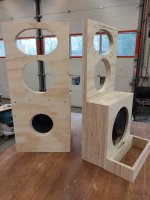I have compared the ripole and the PPD many times. The PPD sounds much more accurate and can be used even with a first-order filter, since the parasitic overshoot due to the fairly long channel of the ripole is practically absent.For those that like the form better than a Ripole, why not build a PPD, but don't expect any wonders.
Sorry, your personal oppinion about something you think you invented, while simply modifying something well known a little.
No measurments with bone on the flesh, no true comparison. The pictures of your measurements only show you manipulated the set up until it showed what you wanted to see or show others. Nearfield nonsense. If you know how wrong you measure, that is lies. If you don't know, learn some basics as you need them in a world of facts.
What you write, for what reason it may be, doesn't have more value than any kind of propaganda.
No measurments with bone on the flesh, no true comparison. The pictures of your measurements only show you manipulated the set up until it showed what you wanted to see or show others. Nearfield nonsense. If you know how wrong you measure, that is lies. If you don't know, learn some basics as you need them in a world of facts.
What you write, for what reason it may be, doesn't have more value than any kind of propaganda.
If your post was intended for me, then you haven't read the thread carefully. Firstly, I am in no way laying claim to Axel's laurels (by the way, aren't you Axel yourself?). I wrote that the PPD is a modification of the ordinary ripole. Secondly, I believe that patent law has long since degenerated into a money trough for bureaucrats. Therefore, I simply shared my experience for free with those who want to get a real result. This thread has everything you need to achieve it. Anyone who wants to can easily repeat it and see for themselves whether there is a positive effect from such a modification.Sorry, your personal oppinion about something you think you invented, while simply modifying something well known a little.
Then call it the "Modified Ripole" or "Ripole Mod", but don't give it your name. That implies you invented something new.
Did you understand why your near field measurements don't give a picture of acoustic reality? Most people use a subwoofer for listening in a room, not only measuring. Try at least a 1 meter distance, like most manufacturers do, if you are used to sit so close to your speakers.
See, I do speaker building for about 50 years now and because I'm a technician, I'm always checking practice and science/ theory. If they don't match, something is wrong.
I can say of my self that I had read any available theory around before I turned 20. Before the internet was invented. I programmed TSP based simulation on a calculator, when major speaker driver companies called TSP "trade secrets". Those were the days, my friend...
Even the Ripole was done long before Axel R. patented it, only seen as useless because of high power demand, lack of cheap amp power and no large, high excursion speaker. By the way, cheap amp power was the main thing that changed speaker building and driver construction in the last decades.
Suddenly, old ideas, that did not work in the past, because of hardware limitations, got re-discovered and now can be used with some success.
The open baffle or folded baffle speaker is in deed the oldest cabinet principle used and tried in any thinkable variation.
Did you understand why your near field measurements don't give a picture of acoustic reality? Most people use a subwoofer for listening in a room, not only measuring. Try at least a 1 meter distance, like most manufacturers do, if you are used to sit so close to your speakers.
See, I do speaker building for about 50 years now and because I'm a technician, I'm always checking practice and science/ theory. If they don't match, something is wrong.
I can say of my self that I had read any available theory around before I turned 20. Before the internet was invented. I programmed TSP based simulation on a calculator, when major speaker driver companies called TSP "trade secrets". Those were the days, my friend...
Even the Ripole was done long before Axel R. patented it, only seen as useless because of high power demand, lack of cheap amp power and no large, high excursion speaker. By the way, cheap amp power was the main thing that changed speaker building and driver construction in the last decades.
Suddenly, old ideas, that did not work in the past, because of hardware limitations, got re-discovered and now can be used with some success.
The open baffle or folded baffle speaker is in deed the oldest cabinet principle used and tried in any thinkable variation.
I'll tell you even more, you don't even need a speaker in the traditional form, and even more so, you don't need any boxes. PPD is also yesterday. Learn to make the right DML loudspeakers and you will refuse to listen to traditional speakers forever.Suddenly, old ideas, that did not work in the past, because of hardware limitations, got re-discovered and now can be used with some success.
Attachments
Sorry, I cant afford Boa Constrictor sized wires. I will keep my speakers. They work with less frightening snakes.
Good DML can be like this, connect it with anything, the sound will be wonderful!They work with less frightening snakes.
Attachments
I have finished my test cabs for the PPD sub with integrated baffle for low-mid and horn.
In the bottem on the back the Hypex FA503 amps with dsp will be placed.
Next step is mounting the drivers and amps and have some measurements for crossover and tuning.
Woofer is Precision Devices PD.153C002
Mid 18 sound 10NMBA520
Horn with CD Beyma CP755ND Al
In the bottem on the back the Hypex FA503 amps with dsp will be placed.
Next step is mounting the drivers and amps and have some measurements for crossover and tuning.
Woofer is Precision Devices PD.153C002
Mid 18 sound 10NMBA520
Horn with CD Beyma CP755ND Al
Attachments
Any measurements / listening impressions yet?I have finished my test cabs for the PPD sub with integrated baffle for low-mid and horn.
In the bottem on the back the Hypex FA503 amps with dsp will be placed.
Next step is mounting the drivers and amps and have some measurements for crossover and tuning.
Woofer is Precision Devices PD.153C002
Mid 18 sound 10NMBA520
Horn with CD Beyma CP755ND Al
Yes
Listening impressions are quite good.
As with open baffle woofers the PPD need boosting to keep up with mid and high, but that is normal.
There is more extended low-end (below 40hz). That was what i was hoping for. Although i am still tuning the system i am quitte happy with the results at this point.
I have made the PPD part of a 3way loudspeaker.
The midwoofer is open baffle. So it lacks some low end. I have the crossover between PPD and mid LR2 at 150hz. That works very well.
Bass is very good articulated. Fast, very good definition. You can hear the different tones very well apart. Also in the lowest regions.
Better than my Faital 15P400 in the OBL-15 open baffle.
I am considering to place the mid in a closed housing to improve the 80-150hz level. Not sure yet. The horn is next level... very very good.
Crossover from mid to horn is now LR2 1300Hz. Also used 850Hz. Both have different sonic signature. Not decided yet what is better.
Overall the speaker is very direct, fast with great dynamics.
Takes quite some time to implement DSP and have listening sessions for best results with family and kids. But no hurry.
Listening impressions are quite good.
As with open baffle woofers the PPD need boosting to keep up with mid and high, but that is normal.
There is more extended low-end (below 40hz). That was what i was hoping for. Although i am still tuning the system i am quitte happy with the results at this point.
I have made the PPD part of a 3way loudspeaker.
The midwoofer is open baffle. So it lacks some low end. I have the crossover between PPD and mid LR2 at 150hz. That works very well.
Bass is very good articulated. Fast, very good definition. You can hear the different tones very well apart. Also in the lowest regions.
Better than my Faital 15P400 in the OBL-15 open baffle.
I am considering to place the mid in a closed housing to improve the 80-150hz level. Not sure yet. The horn is next level... very very good.
Crossover from mid to horn is now LR2 1300Hz. Also used 850Hz. Both have different sonic signature. Not decided yet what is better.
Overall the speaker is very direct, fast with great dynamics.
Takes quite some time to implement DSP and have listening sessions for best results with family and kids. But no hurry.
I have some drivers in stock that seem suitable:
Which one is the most ideal ?
Which one is the most ideal ?
Because a better Bl to Mms ratio ? The Qtc of the Visaton is lower, but that seems less important, and anyhow still within the range that has been experimented with by the inventor.
Because of the Bl to Mms ratio.
The rest is not that relevant.
Xmax is also ok.
But they are both 15" so a ppd housing differs perhaps only on the backside.
You can try them both.
The rest is not that relevant.
Xmax is also ok.
But they are both 15" so a ppd housing differs perhaps only on the backside.
You can try them both.
Try it with a removable backside. Then you can insert the matching backside for each woofer.
I did this to be able to remove the driver without destroying the housing.
See my pictures in this post:
I did this to be able to remove the driver without destroying the housing.
See my pictures in this post:
Hi all,
I cannot handle any simulation tools, I just think I am not smart enough, I have to build it ...
I did just build a PPD subwoofer using a Jensen JWS 300 CP subwoofer driver.
I ordered them some time ago to build such a Ripol:
https://www.diyaudio.com/community/threads/killer-dipole-bass-dirt-cheap.377255/#post-6800320
But I never built it, so I try this one now in a PPD subwoofer.
I measured the TSP for that woofer with LIMP:
Loudspeaker parameters:
Fs = 31.30 Hz
Re = 3.41 ohms[dc]
Le = 671.17 uH
L2 = 1670.11 uH
R2 = 28.27 ohms
Qt = 0.76
Qes = 0.87
Qms = 6.07
Mms = 107.11...
I cannot handle any simulation tools, I just think I am not smart enough, I have to build it ...
I did just build a PPD subwoofer using a Jensen JWS 300 CP subwoofer driver.
I ordered them some time ago to build such a Ripol:
https://www.diyaudio.com/community/threads/killer-dipole-bass-dirt-cheap.377255/#post-6800320
But I never built it, so I try this one now in a PPD subwoofer.
I measured the TSP for that woofer with LIMP:
Loudspeaker parameters:
Fs = 31.30 Hz
Re = 3.41 ohms[dc]
Le = 671.17 uH
L2 = 1670.11 uH
R2 = 28.27 ohms
Qt = 0.76
Qes = 0.87
Qms = 6.07
Mms = 107.11...
I actually bought the Monacor SP-382PA woofers to make 2 Ripoles, with each 2 woofers. The plan comes from an old Klang & Ton design from 2009.The Visation is quite good suited.
The Monacor not so good for the PPD
Does this mean that the Bl / Mms ratio is less critical for a Ripole than for a PP dipole subwoofer?
Last edited:
That 150Hz to 300Hz area is so to read not problematic for a PP dipole. Does that mean the PP Dipole can indeed be crossed at -let's say- 250Hz ?Hi all! I was asked to create this topic as one of the authors of the acoustic design of subwoofers, which was called PPD (Petrenko Petrushevsky's Dipole). In fact, this design, in our opinion, is an improved version of the traditional ripole by Axel Ridtahler. Its main advantage compared to the Axel rippole is the absence of significant unevenness in the frequency response in the region of 150-300 Hz. Additional benefits are lower overall distortion in the subwoofer's operating range and smaller dimensions. With the right choice of TSP speaker parameters, very good results can be obtained, since the smooth frequency response allows the use of second-order filters.
In this video, an example of using a PPD subwoofer on a 15-inch speaker in triphonics.
This is a very simple design compared to other bass cabinets. You should be able to build one and see how it works out for you. A Ripole is all about your listening room and it's position. Anything you can know and say about a Ripole is identical to a so called PPD. Take the word of the PPD "inventor" with a shovel of salt. He refuses to do any objective measurements and doesn't seems to be very open to any critical comment or question. Maybe not wanted in his region. The drivers you have are OK, even as they do not have that much x-max.
The larger the driver, the lower the frequency you have to suppress or filter out. 250 Hz with a 15" seems very critical. You need to measure your individual construction to find out.
The larger the driver, the lower the frequency you have to suppress or filter out. 250 Hz with a 15" seems very critical. You need to measure your individual construction to find out.
Monacor SP-382PA вполне хороши для постройки ППД. Раз у вас закуплено такое количество динамиков, то вы можете построить и риполь и ппд. А затем сравнить их и сделать собственный выбор в сторону лучшего варианта.I actually bought the Monacor SP-382PA woofers to make 2 Ripoles, with each 2 woofers. The plan comes from an old Klang & Ton design from 2009.
Does this mean that the Bl / Mms ratio is less critical for a Ripole than for a PP dipole subwoofer?
Here it is necessary to understand that the LF speaker is designed for optimal work in the low-frequency range. Therefore, giving it the mid-bass range will be a bad idea - distortions will be significant and the quality of work unsatisfactory.That 150Hz to 300Hz area is so to read not problematic for a PP dipole. Does that mean the PP Dipole can indeed be crossed at -let's say- 250Hz ?
Don't judge everyone by yourselfHe refuses to do any objective measurements and doesn't seems to be very open to any critical comment or question. Maybe not wanted in his region.
- Home
- Loudspeakers
- Subwoofers
- PPD subwoofer



